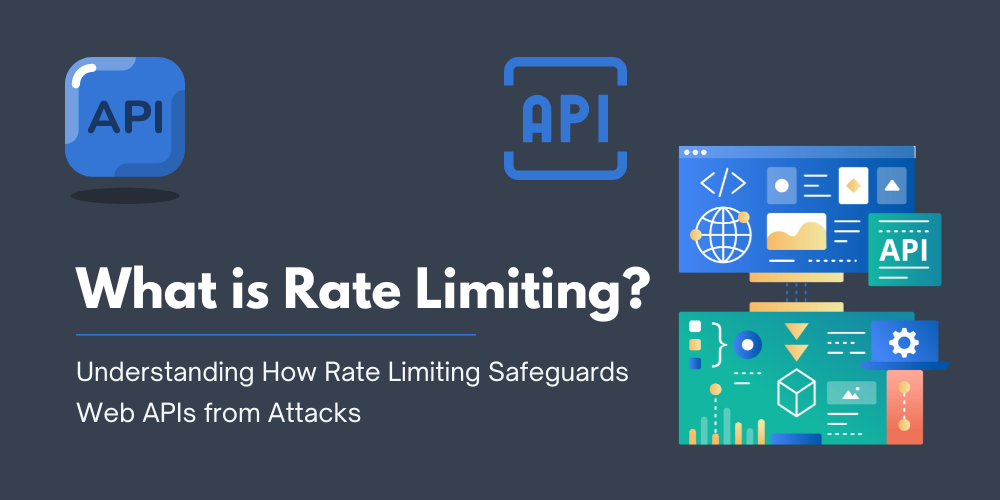Modern applications depend on powerful back-end servers which developers need professional expertise to construct. It becomes essential to ensure proper protection of back-end servers which face threats from hackers and phishers.
Cybercriminals enter servers through weak entry points to disable performance and steal sensitive information using multiple API attacks that involve SQL and NoSQL injections and Distributed Denial-of-Service attacks and malware and other malicious methods.
This article investigates rate limiting as an essential protective method which shields back-end APIs from attacks including DDoS and brute-force and other harmful activities. Rate limiting contains a specific meaning which we need to comprehend before proceeding.
What is Rate Limiting?
Rate limiting operates as a system which restricts the amount of back-end server requests made by clients throughout a time interval to avoid continuous or multiple requests.
What are the essential reasons for implementing rate limiting systems during API creation? A description of the critical factors can be found in the next segment.
Importance of Rate Limiting
The following outlines fundamental reasons why back-end application developers need rate limiting:
DDoS Attacks
The first defensive mechanism rate limiting provides protection against DDoS assault attempts by regulating endpoint server request volume irrespective of source through automated bots thereby maintaining server operational efficiency and uninterrupted service delivery.
The three main types of DDoS attacks include volumetric attacks, protocol attacks and application layer attacks. An attack similar to this one took place on GitHub in 2018.
Web Scraping
Web application and server protection is enhanced by rate limiting because it defends against unauthorized web scraping and crawler activity. A steady stream of automated tool requests runs continuously for website data extraction exposing website information that could be sensitive. The use of a powerful rate limiter stops unauthorized access attempts and data scraping incidents from occurring.
Brute Force Attack
The attack method requires bots to automate manual attempts of every configuration on a server to access resources which currently needs human intervention but will eventually be automated because of its resource Requirement. Rate limiting functions as an attack prevention method by stopping overreaching request volumes when defined time limitations are met.
Resource Optimization
API owners face two types of expenses for serving requests which include maintenance alongside running costs. Rate limiters help control request volumes which results in lower operational expenses as well as operational efficiency improvement. This section introduces several algorithms that can be employed in creating rate limiters.
Adoption and Usage of Rate-Limiting by Popular Sites
The technology industry extensively uses rate limiting features in applications of all sizes. Through its current APIs Twitter (also known as X) uses rate limit features to deliver access to several features including the sign-up extension.
Twitter users can make 50 tweet post requests each day through its interfaces under its rate limit policy.
Other Real life Use-cases of API Rate Limiting
APIs serve purposes beyond their use at Twitter and its similar popular sites. The implementation of rate limiting occurs in multiple practical situations that extend past the scope of Twitter API usage.
Reducing the Incidence of Spamming
Research data indicates daily spam email transmission exceeds 160 billion and this leads messaging and email platforms to implement rate limiting mechanisms as a spam and unsolicited content control measure. The platform maintains its integrity and monitors responsible usage due to this method which establishes time boundaries.
Tackling Fraudulent Activities
Rate limiting functions as a standard web application security mechanism to discover strange activities which point towards user-based fraudulent intentions. Rate limiting serves to stop and reduce the progression of current fraudulent payments while safeguarding the application server against harmful actions.
Disabling Malicious User Authentication
Online attackers perform brute force attacks and DDoS operations and different methods to break into user accounts on web servers.
Several websites protect their web security through rate limiting systems that enforce restricted login trial counts within defined periods.
How Does Rate Limiting Work?
Different algorithm structures form the basis of rate-limiting tools which establish how these tools operate. Server performance and efficiency receive benefits through algorithmic control which regulates server request volume at each time period.
Examples of Rate Limiting Algorithms
These are the rate-limiting algorithms which have become the most prevalent ones in use:
Fixed Window Algorithm
The algorithm implements a predefined duration of scheduling time where each client receives a predetermined number of requests to access the server. It controls all request rates at a steady pace even if numerous clients use the API at the same time.
During a five-minute request limit period all clients must wait until five minutes passes before they can access the endpoint. The model operates simply but proves ineffective because of its restricted access rules.
Sliding Window Algorithm
The scheduler system adopts the fixed window procedure to enable unique support opportunities for every individual customer. The system manages client requests by giving each of them their own designated time slot which allows flexible and efficient service regulation.
The Client can perform ten requests within their allocated period that extends between 10:00 and 10:03. The program allows Client B to submit up to ten requests during the time period from 10:02 to 10:05. The application design gives every client their own individual time slot for requesting access.
Leaking Bucket Algorithm
The algorithm bases its operation on the “leaking bucket” model to enforce server request rate limits for increased operational speed. Requests surpassing this threshold automatically result in errors 429 which the server returns to the user. The method serves to avoid server overload which sustains both speed and efficiency.
Token Bucket Algorithm
The model functions similarly to the leaking bucket algorithm by employing a concept which manages tokens in a hypothetical bucket system. The bucket accepts new tokens according to a schedule while each incoming request automatically consumes one token.
Further requests that run out of tokens get rejected with error 429. Server congestion prevention along with optimal efficiency result from this method.
Rate Limiting Best Practices
Web API development effectiveness depends on proper implementation of established practices. The following strategies enable full utilization of rate limiting as an API security mechanism:
- The initial step requires selection of a rate-limiting algorithm that suits your needs. A strong rate-limiting algorithm requires implementation to achieve the best possible results. The selection of an algorithm must match your API endpoint requirements for maximum effectiveness in rate-limiting operation.
- The established rate limits should fall within practical boundaries. Rate limits with arbitrary values will create user dissatisfaction and run contrary to the purpose of protection through rate limiting. Users achieve better satisfaction when organizations enforce balanced time limits which simultaneously protect against attacks.
- Develop efficient error management systems which present distinct feedback to clients. Clients encounter standard error code 429 when their request rate exceeds the limit. Users need proper error management for API misuse to achieve smooth interactions with the system.
- Organizations should use adjustable rate-limiting protocols that adjust per distinct measurable factors. A standard time interval distribution among all endpoints proves ineffective because various endpoints display different sensitivities toward received data. The configuration of rate parameters according to endpoint sensitivity serves to optimize server performance while securing its operations.
- Implement tools that permit proper application logging and monitoring alongside observation functions to obtain visibility. Web API security is enhanced through tracking server activities with API metrics and logs and monitoring systems. The notification system based on alert monitoring sends notifications about suspicious requests directly to developers so they can act on potential threats immediately.
- Other API security methods should have their synchronization settings aligned with rate limiting components. When security protocols exist the proper alignment of rate limiters creates greater protection for the API. Before implementing these measures users need extensive knowledge and expertise to prevent their integration from creating security conflicts that will undermine protection efforts.
- Ensure comprehensive API documentation. The documentation needs to present clear details about rate-limiting policies to assist users developers and clients regarding their API interaction within set boundaries.
Conclusion
This conclusion summarizes rate limiting as a vital API security hack alongside real examples of its practical usage.
Read my additional articles by exploring this page. Take care and continue designing your code.



